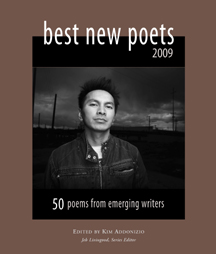Book Review
Best New Poets 2009: 50 Poems from Emerging Writers by Kim Addonizio(ed). Charlottesville, VA: Samovar Press, 2009. $11.95
Reviewed by Erik Richardson
The University of Virginia’s Best New Poets 2009 is the fifth in the series. The final anthology was culled down from roughly 3,500 submitted poems sent in by MFA programs, literary journals, and, sometimes, by the poets themselves. Dedicated readers brought that pile down to 175 poems which then went on to guest editor Kim Addonizio who picked out the top 50.
One of the interesting strengths of an anthology of this sort is that it offers the reader such a wide range of styles and moods and yet, like any collection—but perhaps more regrettably in a “best of” collection—this book offers a range of quality as well. Even as the reader wanders among narrative poems, cinquains, kletics, and elegies, among others, she also finds herself trudging through low points like David Silverstein’s oddly random "Metamorphosis," the rambling "Nostalgia" by Matthew Poindexter, or the jarringly disjointed "From the Uncollected Works of Sallie Chisum" by Warren Heiti.
Still, there are some powerful, graceful poems here that make it well worth picking up a copy of the collection, even if they are the only ones you read. One of those is "Elegy for the Emptied Prairie." Another is "Thirteen," by Caitlin Doyle, which is such a remarkable combination of ideas and word-play around the transformations to a girl in her thirteenth year that it is like a socks-on-carpet spark to the brain.
More interesting than the range of styles and even quality in the collection is that it still manages to provide centers of conceptual mass that give the collection a feel of stability, with the primary such being death. The strength of this dominant theme does much to give the collection substance and draw the reader into a stable orbit, whether we are talking about a more light-hearted example, where Death shows up at a failing birthday party, and, “a rumor began circulating that he had spiked the punch,” or one of the heavier examples, like Joe Wilkins’ "Notes from the Journey Westward," which opens with, “We died in the wagon. We had been sick since Wyoming, [ . . . ] In our fever / the angels came. They had no teeth.”
Several of the poems also feature a secondary theme—the prairie—by way of background scenery, though its role takes on mass through its recurrent move to the foreground, perhaps best seen in Benjamin Dombroski’s "Elegy for the Emptied Prairie."
There are also several interesting elements which recur in enough places to suggest their roles as greater and lesser moons, such as space itself (“. . . quiet night, dust of stars scrawled through interstices of ancient trees”), trains (“. . . the halting clank of car meeting car / echoes through sleep, line snaking back/ along the lip of the river like a slow tune . . .”), and even surgery (from Walt Whitman dressing wounds during the war to a heart surgeon carving out an antelope’s heart, “. . . before the blood begins to clot/because it’s so close to a human / heart—loves to show off his art . . .”).
In a similar fashion, it is also interesting to mention a couple of points where we see a certain reflection of Addonizio’s own amazing talent at grabbing and grappling with darker, grittier themes. A couple of examples of this are the scene where severed limbs are stacked against a wagon (Reeves' "Kletic of Walt Whitman, the Wound Dresser") and one in which a young graffiti artist is imagining sex in the shelter of a dank and rotting covered bridge littered with crushed cans and shriveled condoms (Crews' "Sex in the Rain"). The most interesting instance, though, is when a character opens her mouth to calm herself, “there there,” at which point a reader familiar with Addonizio’s roller-coaster drop, "There, There" will hear faint echoes of a darker voice.
The sun at the center of this metaphorical solar system, however, is the piece by Tana Jean Welch, "Sometimes, the Trip Across the Continent is Enough". The way the story intertwines a friend’s struggle-filled journey with the Lewis and Clark expedition is masterfully done. Even without the story, some of the images could stand on their own as small marvels, such as a suicidal friend's white dress waving in the wind like, “the full sail of the best pirate ship, / Queen Anne’s Revenge,” or
Mrs. Grinder, the keeper
of Grinder’s Inn outside Nashville, found Lewis
with a razor,
cutting his flesh from head to toe. Bleeding
from two bullet holes in his breast.
She slept
Every night after, knowing his marred body
was buried a few yards from her porch.
Because of these various major and minor elements of gravitational attraction shared between poems, the collection overall seems to rise up above its origins as a diversely authored anthology, taking on some of the personality and feel of a single author’s collection. That is a feat well worth seeing for its own sake.
Erik Richardson is a schoolteacher and freelance writer in Milwaukee. Recent work has appeared in Arbor Vitae, Sein und Werden, and Wisconsin People & Ideas (forthcoming). He won the 2009 & 2010 Gahagan Prize in Poetry and publishes a modest poetry journal for young people: Signs & Wonders.


